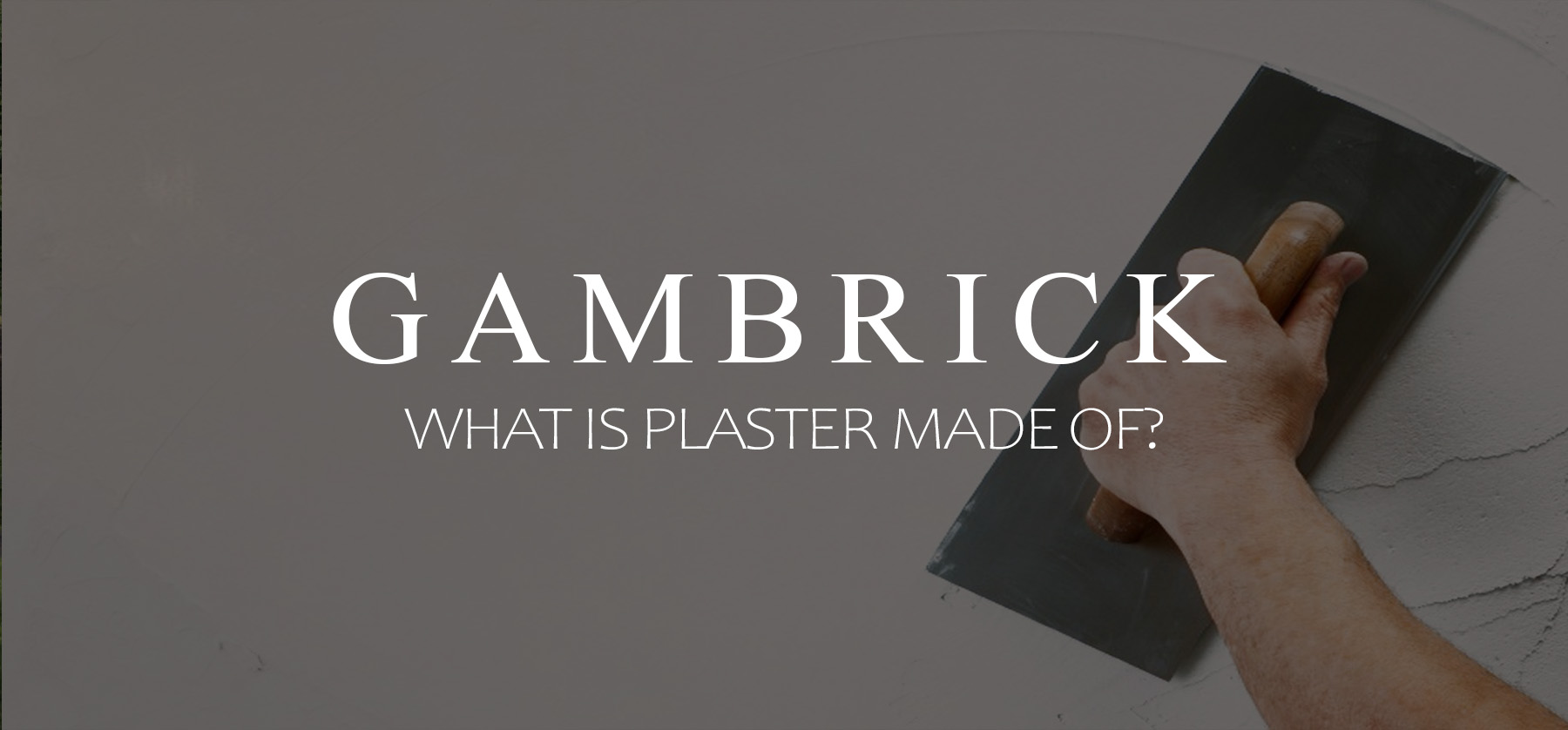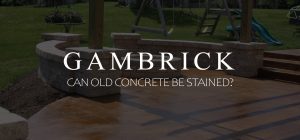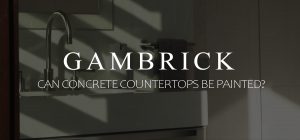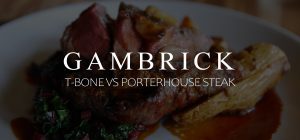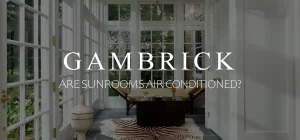What Is Plaster Made Of?
Plaster is made by mixing sand and cement with water. But you can also make it by mixing cement, sand, lime or gypsum with water in different amounts. There are different types of plaster which use a variety of local ingredients depending on where it’s made. These include slaked lime Ca(OH)2, Venetian which includes pigment and marble dust, gypsum, clay, and Moroccan called Tadelakt which is made out of lime and black soap made from olives. Many types of ancient plaster even included binding materials like hair and straw. But in modern times it’s typically a mixture of cement, sand and lime with water.
Plaster is similar to cement in that it’s a paste when wet but dries extremely hard with a gritty texture. It’s a composite material where each ingredient gives it a different quality. Cement is the binder that makes it sticky, sand gives it grit and lime adds strength. Water activates the cement and turns dry powder into a sticky paste that later dries hard like a rock.
Water is a very important ingredient because it activates the cement and makes it sticky. But it should be used sparingly. Add just enough water to mix the ingredient thoroughly and not a drop more. You don’t want watery or dry and powdery plaster.
The amount of each ingredient used is called the mortar mix ratio. An all around good mix is 1:4 which is 1 part cement / 4 parts sand. I use 1:4 for the base coat when I do plaster work. 1:6:1 is another good mix ratio which is 1 part cement / 6 parts sand / 1 part lime. It’s a great mix for finish coats because the lime makes it smoother and harder.
What Are The Ingredients In Plaster?
Clay, lime, gypsum, sand, cement, mud and even animal hair are all ingredients that have been used to make plaster. There’s no one way to make it. It’s been around for thousands of years and was usually made from locally sourced ingredients. But in modern times, it’s made from cement, sand and lime. If you read the ingredients on a premixed bag of plaster, those 3 ingredients and some additional additives like hardeners, color or a plasticizer are what it’s made out of.
- Most plasters made today contains the ingredients lime, gypsum, sand, cement and water. It’s very cheap and easy to make. Which is why it’s such a popular building material around the world.
- Premixed bagged plaster usually contains additives like color, hardeners and a plasticizer.
There are dozens of ways to make plaster. Most homes in Europe, Asia, South America and Africa cover their walls and ceilings with it. Locally sourced ingredients like clay, cement, sand, gypsum, animal hair, straw and mud can be mixed to create different forms with varying properties. Some version, like Moroccan tadelakt, are even waterproof. Venetian is white and dries to a super fine with quality suitable for a palace.
Pigment can be added when the product is wet to create all sorts of colors. White Venetian is one popular example and a very beautiful look.
Early American homes and buildings used plaster made from lime. When mixed with sand, cattle hair and water, the putty like substance was applied to walls and ceilings and allowed to set. Once dry, the surface was extremely durable and resembled limestone.
What Is The Main Ingredient In Plaster?
The main ingredient used to make plaster is cement, lie or gypsum. These are all active ingredient that activate when mixed with water to make plaster a sticky paste. When each of these ingredients eventually dries, called curing, they become hard like a rock. This is what creates a flat, dense and durable plastered surface.
Other ingredients, like clay, hairs, fibers, sand and colors are added to give the plaster additional properties.
- Sand: Gives the plaster grit and strength.
- Colors: Tint the plaster a specific color so you don’t have to paint it later. White is by far the most popular because it’s used to make Venetian plaster.
- Hair: Historically, hair was added to plaster as a binding agent.
- Additives: Modern plasters use chemical additives like hardeners and plasticizers to the mixture.
- Clay: Can be used for strength and texture.
Because plaster is made all over the world out of local ingredients, there’s no one way to make it. However, modern plaster is mostly made from cement, sand and lime. It may also contain some additives and colors if you you buy it commercially produced in bags.
How To Mix Plaster DIY
When you’re plastering over brick, stone, concrete or wood, it’s very important to mix the correct type of plaster. For small jobs and repair work, I like to use a premix that comes in bags because it’s faster and more convenient. But for larger jobs I mix my own.
Basic plaster is made from sand and cement mixed with water. The amount of sand to cement you use is called the mix ratio. The basic mix I use for plastering a base coat is 1 part cement / 4 parts sand. This is a really good all around plaster with good strength, durability and adherence.
For the finish coat I use a mix ratio is 1 part cement / 6 parts sand / 1 part lime. Adding lime makes the plaster harder, more durable and smoother.
- A 1:4 mix ratio is a great all around base coat.
- I use a 1 par cement / 6 parts sand / 1 part lime mix for my finish coat. Adding lime makes the plaster harder, more durable and smoother.
- You can alter the mix ratio depending on where you’re working and the type of brick your plastering.
- Plaster and mortar mix ratios are listed cement / sand / lime. For example, 1:5:1 is 1 part cement / 5 parts sand / 1 part lime.
Plaster ingredients are measured in equal parts. But how you gather your ingredients is up to you. Some masons use buckets, shovels or scoops. As long as each ingredient is measured equally it doesn’t matter. However, it’s best to use small measurements for small jobs and large measurements for larger projects.
Plaster Mix Ratios
Below is a chart of all the plaster mix ratios I use and when I use them.
| Mix | Ingredient Ratio | Application |
| 1:3 |
1 part cement / 3 parts sand | A stronger mortar that’s good for repair work & filling in cracks. It’s not great for large areas because it’s harder to spread that 1:4. |
| 1:4 | 1 part cement / 4 parts sand | This is the best all around plaster mix ratio. Great for interior and exterior work. Can be used for base and finish coats. |
| 1:5 | 1 part cement / 5 parts sand | For interior work only. Weaker than 1:4 which makes it better for aging brick and mortar. Softer than 1:4 which gives it an aged feel. |
| 1:6 | 1 part cement / 6 parts sand | For interior work only. Weaker than 1:5 which makes it ideal for older, brittle brick and mortar. It has an aged appearance and feel which makes it great for historical work and restorations. |
| 1:6:1 | 1 part cement / 6 parts sand / 1 part lime | A great all around interior/exterior finish coat mix. Adding plaster to base 1:4 makes it denser, harder and smoother. |
Basic plaster mixes contain just sand and cement. This is for exterior and interior brick and both base and finish coats. But adding some lime to your finish coat makes it denser, more durable and smoother.
If you decide to use a little lime, make sure to also include more sand to balance out the mixture.
Commercial Plaster
If you’re buying bagged plaster that’s been commercially made, it’ll contain lime or gypsum, sand and cement. Usually it’s a cement based product with very fine sand to make the plaster smoother. Some manufacturers will also include some pigment for color and other additives like a hardener or a plasticizer to make it more workable.
- The most popular types of plaster include white pigment as an ingredient which makes it look Venetian. The whiter the better in my opinion. I like my plaster to be extremely white and very fine. This is possible by using very fine sand, cement and white pigment.
- The finer the sand the better if you want a smooth surface. You can even get white sand which makes creating a super white Venetian finish even easier. Cement comes white too which is an added bonus.
- If you want more grit use sand with larger aggregate.
Southwestern style plaster is made more brown like a natural clay color. You can achieve this look by using brown sands and tan pigment. I also use a coarser sand. Southwestern style finishes are typically rougher and more rustic. While Modern finishes tend to be much smoother.
No matter how you adjust your plaster’s ingredients, make sure not to over water it. Use just enough water to activate all the cement and not a drop more. What you want is a paste like wet clay. If the product is watery you won’t be able to spread it properly. It’ll fall right off the walls and ceilings.
Plaster Of Paris Is A Popular Form Of Plaster
Plaster of Paris is one of three types of plaster. The other two are lime-plaster, which is made from calcium hydroxide and sand, and cement-plaster, which is a combination of sand, Portland cement and water.
- Plaster of Paris is one of the most commonly used and is also called gypsum-plaster.
- Plaster of Paris is a mixture of powdered calcium sulphate (commonly known as gypsum) and water that hardens quickly. It’s made by heating the gypsum to 150 degrees centigrade, and then mixing the dry powder with water. The powdered gypsum is then mixed about two parts powder to one part water, which creates a white a paste.
Plaster of Paris can be applied as a wall and ceiling covering, but it’s more commonly used to make decorative elements. Things like cast products, statues and trim. It dries very hard and takes the shape of any mold it’s poured into. And it’s fairly easy to shape which is how builders turn it into trim and other decorative elements.
The paste dries with a super smooth surface which makes it great for pouring into molds. It’ll take the exact shape of any mold you pour it into. You can reproduce existing products, like statues, by making a mold and then filling that mold with Plaster-of-Paris.
What Holds Plaster Together?
Clay, lime, gypsum, sand and mud are just a few common ingredients used to make plaster. But something has to hold them all together in order to form a new substance. This is called a binding agent and it’s what makes plaster possible. Without a binding agent, you’d have a bunch of random ingredients mixed together that would easily fall apart. Binders give the plaster structural integrity, durability and strength. They also help maintain it’s rock hard surface.
The binding agent used varies based on where the plaster is made and when. In ancient times, the most common type of binder was animal hair. But these days modern plaster is usually made with cement. Both ingredients crystalize when hardened to become almost rock hard. This drying and hardening is called curing.
Lime based mixes are also very common and include fibers as a binder.
Is Plaster Used Today?
Yes, plaster is still in use today all over the world. It’ll most likely be used in some form forever because you can make it out of ingredients you find in nature. It’s a natural product that can be locally sourced which makes it very affordable and accessible to just about anyone.
Here in the US it’s been replaced almost entirely by drywall. Although the material itself is cheaper than drywall per square foot, it requires a lot more labor and skill to apply.
Drywall and spackle are much easier and faster to install than slats and plaster. Most plaster jobs cost between $5-$10 per square foot on average. And that generally doesn’t include all the preparation work. It’s like an art form that most builders don’t even know how to do anymore.
Labor is expensive so builders have pretty much all made the switch to drywall. Almost no modern homes built in the US use plaster as their main wall or ceiling finish. But some very high end homes still do. The surface quality is hard to beat with any other material.
Does Plaster Contain Cement?
Yes, the most common forms of plaster contain either gypsum, lime, or cement. It’s the active ingredient and binding agent. Cement activates when mixed with water to become a paste that binds all the ingredients together. As it dries and hardens, it becomes solid and strong. This process is called hydration or curing.
Plaster is manufactured as a dry powder that is mixed with water. It comes in buckets or bags.
Mixing the product with water forms a stiff workable paste like clay. If the product is too dry or watery, adjust the amount of water/powder ratio you used. Getting the water level correct when mixing is very important.
Natural Plaster
It’s possible to make an all natural plaster than works really well as a ceiling or wall finish. It can be applied to masonry, wood slats or even to drywall board. Natural products are a great alternative to commercially made plasters because they don’t contain chemicals.
Chemicals used in drywall and plaster can create a form of indoor air pollution called gassing. Chemical toxins can be released from the product inside your home which can make you sick.
The majority of natural plasters are made from a combination of simple ingredients: Clay, sand, straw, lime, pigments, and water.
Here’s a basic recipe of what earthen plaster is made of that you can try out yourself DIY:
- 1 part clay-rich soil
- 2 parts sand
- 1/4 part chopped straw
- Add lime and pigments as needed
Add in lime and pigments slowly. I recommend making a few small test batches with different amount of lime and pigment until you reach the consistency you want. I like a denser, harder finish so I use more lime, but it’s harder to work with and spread.
Adjust the pigment level based on the color you want. The more natural a look you want, the less pigment you should use.
Add just enough water to turn the ingredients into a paste. If there’s still powder in your mixing bowl you need more water. But never use too much water. Watery plaster will be impossible to spread on the walls and/or ceilings.
Summary: What Is Plaster Made Of?
Plaster is made by mixing sand and cement with water. But you can also make it by mixing cement, sand, lime or gypsum with water in different amounts. There are different types of plasters which use a variety of local ingredients depending on where it’s made. These include slaked lime Ca(OH)2, Venetian which includes pigment and marble dust, gypsum, clay, and Moroccan called Tadelakt which is made out of lime and black soap made from olives. Many types of ancient plasters even included binding materials like hair and straw. But in modern times it’s typically a mixture of cement, sand and lime with water.
Plaster is similar to cement in that it’s a paste when wet but dries extremely hard with a gritty texture. Each ingredient gives it a different quality. Cement is the binder that makes it sticky, sand gives it grit and lime adds strength. Water activates the cement and turns dry powder into a wet paste that later dries hard like a rock.
Water is a very important ingredient because it activates the cement and makes it sticky. But use it sparingly. Add just enough water to mix the ingredient thoroughly. You don’t want watery or dry and powdery plaster.
The amount of each ingredient used is called the mortar mix ratio. An all around good mix is 1:4 which is 1 part cement / 4 parts sand. I use 1:4 for the base coat when I do plaster work. 1:6:1 is another good mix ratio which is 1 part cement / 6 parts sand / 1 part lime. It’s a great mix for finish coats because the lime makes it smoother and harder.
If you have any questions or comments about plaster, email any time.
